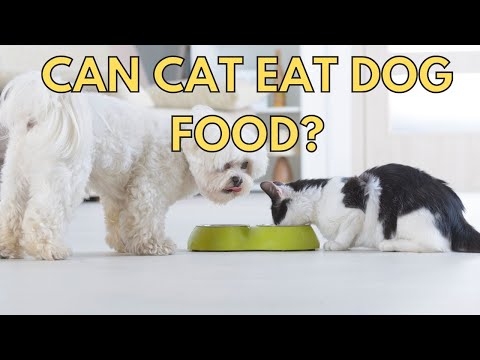In multi-pet households, it’s not uncommon for pets to sneak a bite from each other’s meals. Many pet owners wonder if this behavior is safe, especially when it comes to their furry friends sharing cat food. While it’s not toxic, cat food isn’t designed to meet the nutritional needs of dogs.

Cat food often contains higher levels of protein and fat, which can lead to digestive issues or long-term health problems for dogs. Veterinarians recommend sticking to species-specific diets to ensure optimal nutrition. Brands like Royal Canin and Purina Pro Plan offer tailored options for both cats and dogs.
This article explores the risks, nutritional differences, and strategies to prevent pets from eating each other’s meals. Understanding these factors helps pet owners make informed decisions for their companions’ well-being.
Key Takeaways
- Cat food is not toxic but lacks proper nutrition for dogs.
- High protein and fat content in cat food can cause digestive issues.
- Species-specific diets are essential for long-term health.
- Veterinarian-recommended brands include Royal Canin and Purina Pro Plan.
- Preventing pets from sharing meals supports their overall well-being.
Introduction: Can Dogs Eat Cat Food?
Pet owners often notice their furry companions swapping dishes. This behavior is especially common in homes with both cats and dogs. While it may seem harmless, the nutritional needs of these animals differ significantly.
One reason dogs are drawn to cat food is its high protein content. Cats require a minimum of 26% protein, while dogs only need 18%, according to AAFCO standards. The strong aroma of cat food also makes it more appealing to their canine counterparts.
Occasional nibbling on cat food is unlikely to cause harm. However, regular feeding can lead to imbalances in a dog’s diet. This is because cat food lacks the essential nutrients tailored specifically for dogs.
In multi-pet households, accidental consumption often occurs when food bowls are left unattended. Pets may also sneak bites when their owners aren’t looking. Understanding these scenarios helps prevent such incidents.
While the occasional bite isn’t dangerous, consistent eating cat food can lead to health issues. The next sections will explore the short-term and long-term effects of this behavior.
What Happens If a Dog Eats Cat Food?
When pets share meals, it can lead to unexpected health concerns. While occasional nibbling might not cause harm, regular consumption of cat food can have both short-term and long-term effects on their well-being.

Short-Term Effects
Consuming cat food often results in immediate discomfort. About 45% of pets experience gastrointestinal distress within six hours. Common symptoms include vomiting, diarrhea, and abdominal pain. These issues arise because cat food is higher in fat and protein than what most pets can tolerate.
Long-Term Health Risks
Over time, eating cat food can lead to more serious conditions. The high-fat content increases the risk of pancreatitis, especially in breeds like Miniature Schnauzers. Excess protein can strain the liver and kidneys, while prolonged consumption may contribute to obesity.
Certain breeds, such as Cocker Spaniels, are more vulnerable to these risks. Pet owners should monitor their companions closely and ensure they stick to species-specific diets for optimal health.
Nutritional Differences Between Dog and Cat Food
The nutritional profiles of pet meals vary significantly between species. Cats are obligate carnivores, meaning they rely on animal-based proteins for survival. On the other hand, pets like dogs are omnivores, requiring a balanced mix of plant and animal sources.

Protein and Fat Content
Cat meals typically contain higher levels of protein and fat. For example, cats need at least 26% protein, while dogs thrive on 18%. The increased fat content in cat meals can lead to digestive issues for other pets if consumed regularly.
Essential Nutrients
Certain nutrients are critical for cats but not for dogs. Taurine, an amino acid, is essential for feline health, with requirements ranging from 0.1-0.2%. Dogs, however, produce taurine naturally and do not need it in their diet.
Vitamin A levels also differ. Cats require 3,332 IU/kg, while dogs need 5,000 IU/kg. Additionally, calcium ratios impact bone health, with disparities in absorption rates between species. Understanding these nutritional requirements ensures pets receive the right balance for their well-being.
Is Cat Food Safe for Dogs in Small Amounts?
Many households with multiple pets face the challenge of meal-sharing between their furry friends. While it’s not ideal, occasional consumption of cat food is generally safe for other pets. Veterinarians approve this in small amounts, with 92% agreeing that accidental nibbling isn’t harmful.
For safety, the threshold should be less than 10% of daily calories. This ensures the diet remains balanced and species-specific. Smaller pets, like Chihuahuas, should consume even less due to their size and weight.
In emergencies, such as natural disasters, cat food can serve as a temporary substitute. However, it’s not a long-term solution. The high caloric density, averaging 100 calories per ounce, can lead to weight gain if used over time.
Veterinarians sometimes make exceptions, like during post-surgery recovery. In these cases, cat food may provide the extra protein needed for healing. Always consult a professional before making such changes to ensure your pet’s balance and health.
“Occasional feeding cat food is acceptable, but it’s crucial to monitor portions and frequency.”
Understanding these guidelines helps pet owners make informed decisions. While small amounts are safe, sticking to species-specific meals ensures long-term well-being.
How to Prevent Your Dog from Eating Cat Food
Managing meal times in homes with multiple pets requires careful planning. Ensuring each companion sticks to their own meals supports their needs and prevents health issues. Simple strategies and adjustments can make a big difference.
Feeding Strategies
One effective approach is to schedule feeding times rather than leaving food out all day. This reduces the chance of pets accessing each other’s meals. Microchip-activated feeders are another solution, reducing food theft by 83%.
Here are some additional tips:
- Use elevated surfaces for cat bowls to limit access.
- Implement crate training during feline meal times.
- Choose scent deterrents around cat food stations.
Environmental Adjustments
Creating separate feeding zones can help. Baby gates or designated rooms keep pets apart during meals. Elevated surfaces prevent 67% of access attempts, making it harder for other companions to reach the bowl.
These environmental changes ensure pets enjoy their foods without interference. By combining these strategies, pet owners can maintain harmony and health in multi-pet households.
What to Do If Your Dog Eats Cat Food
Accidental consumption of the wrong meal can happen in households with multiple pets. While occasional nibbling isn’t usually harmful, it’s important to know how to respond if your companion consumes a significant amount. Taking the right steps ensures their health and prevents complications.
Immediate Actions
If your companion eats cat food, start by monitoring their behavior closely. A 12-hour observation window is recommended to check for any adverse reactions. Ensure they stay hydrated, as dehydration can worsen symptoms like vomiting or diarrhea.
Here’s a step-by-step home care protocol:
- Remove access to the meal to prevent further consumption.
- Offer fresh water to maintain hydration levels.
- Watch for signs of discomfort, such as abdominal pain or lethargy.
When to Contact a Veterinarian
Certain symptoms require immediate professional attention. If your companion shows signs like bloody stool, tremors, or prolonged lethargy, contact a vet right away. These could indicate serious issues, such as pancreatitis, which has treatment costs averaging $1,200-$3,500.
Prepare an emergency checklist for the vet visit:
- Note the quantity and type of meal consumed.
- Provide details about their overall nutrient intake.
- Share any pre-existing conditions affecting their liver or kidney.
Long-term monitoring is essential to ensure no organ stress develops. Regular check-ups help maintain their well-being and prevent future incidents.
Conclusion: Should Dogs Eat Cat Food?
Understanding the distinct dietary requirements of pets is crucial for their long-term health. Cats and dogs have unique biological needs, and their meals are formulated to meet these specific nutritional demands. Sharing meals can disrupt this balance, leading to potential health issues.
Preventive measures, such as scheduled feeding and separate meal zones, are more effective than treating problems later. While occasional nibbling isn’t harmful, consistent sharing of meals is not recommended. In emergencies, it may serve as a temporary solution, but species-specific diets should always be prioritized.
Annual nutritional assessments by a veterinarian ensure pets receive the right nutrients. For immediate concerns, contact the ASPCA Animal Poison Control at (888) 426-4435. Prioritizing proper nutrition supports a longer, healthier life for your companions.



